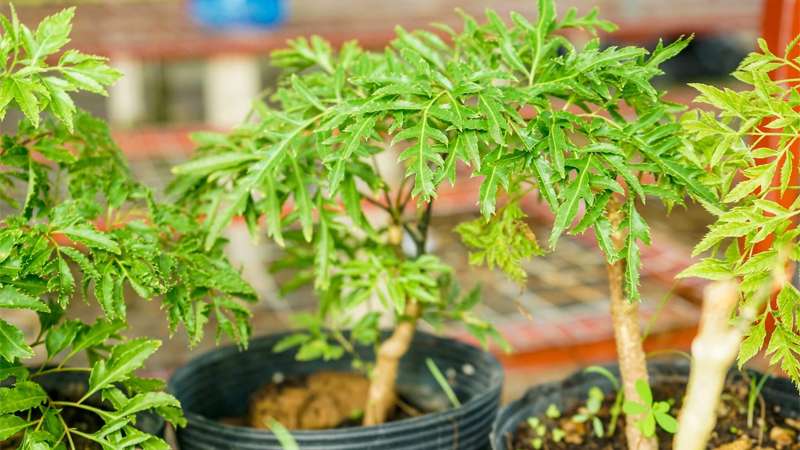Morphological characteristics of the Ding Ling tree
The Ding Ling tree is of the same family as ginseng, with a small, upright trunk, reaching a height of about 1-2m. Its branches grow irregularly, and its leaves have uneven, sharp serrations. The Ding Ling flowers are pale green or white, and its fruits are silver-white clusters of oval-shaped berries with elongated tips.
The Ding Ling tree is also known as the “fish salad tree,” and it is commonly grown in Vietnam for ornamental purposes and medicinal use.
There are several varieties of Ding Ling trees, such as the small-leaved Ding Ling, the round-leaved Ding Ling, and roasted Ding Ling, among others. All varieties have a fragrant smell, with the small-leaved Ding Ling being the most commonly grown and used.

Feng shui significance of the Ding Ling tree
The Ding Ling tree is a widely cultivated plant that can be used for landscaping, culinary purposes, and medicinal use. It can be used as a spice or vegetable in cooking, either raw as part of a salad or cooked in soups, stews, and stir-fries.
The Ding Ling tree is known as the “ginseng of the poor.” All parts of the tree, including the trunk, leaves, and roots, have medicinal properties. The leaves have detoxifying and cooling effects, can relieve itching and treat acne, and have anti-allergic properties. The trunk can treat joint and bone diseases, and the roots are considered a valuable herbal remedy.

Furthermore, the Ding Ling tree has special feng shui significance for homes.
In terms of feng shui, the Ding Ling tree helps to block negative energy from entering the house, promoting positive energy flow and accumulation of wealth. This tree is considered a “guardian” in the house. Planting a Ding Ling tree brings prosperity to the family.
Planting location for the Ding Ling tree
The best location to plant a Ding Ling tree is in front of the house. According to folklore, planting a Ding Ling tree in front of the house helps to block negative energy and attract wealth. The Ding Ling tree helps to retain money and assets in the house and prevent them from being lost, as well as limit negative influences from entering the house.
However, when planting a Ding Ling tree in front of the house, it should not obstruct the pathway. It is advisable to plant the tree slightly to one side, allowing for a clear pathway and easy movement. Only then will the Ding Ling tree have the desired effect of attracting positive energy into the house.
The Ding Ling tree should also not be planted too close to a wall. It is preferable to plant it in a sunny location to facilitate its healthy growth.
Additionally, the Ding Ling tree can be placed on balconies, porches, gardens, and can also be potted and placed in bedrooms. Note that if placed in a bedroom, it is best to choose a medium-sized tree and position it near a window or balcony, as the tree can absorb oxygen at night.

Health benefits
In addition to being used for landscaping, the Ding Ling tree is known for its versatile uses in culinary and medicinal applications.
The small, serrated leaves of the Ding Ling tree are commonly used as raw vegetables in salads or used to wrap and serve spring rolls.
Furthermore, the dried leaves of the Ding Ling tree can be stir-fried with snakehead fish or mud carp, resulting in a flavorful and nutritious dish. The Ding Ling root can be soaked in alcohol and is favored by fathers.
In traditional medicine, the Ding Ling tree is regarded as the “ginseng of the poor” and is used to treat various chronic illnesses.
The leaves of the Ding Ling tree can be boiled to make a drink that replenishes essential nutrients and promotes overall well-being. Ding Ling is used for preventing and treating conditions such as memory loss, stress, nervous exhaustion, dizziness, insomnia, and more.
For elderly individuals, Ding Ling can be used to alleviate conditions such as back pain, knee pain, joint pain, and relief can be achieved by drinking a concoction of Ding Ling leaf extract along with certain traditional Chinese herbal medicines prescribed by a physician.
For skin conditions such as hives and itching due to allergies, consuming dried Ding Ling leaves can provide quick relief. When injured externally, chewing or applying crushed Ding Ling leaves to the affected area can alleviate pain.
Ding Ling is also used to treat conditions such as urinary difficulty, erectile dysfunction, asthma, malaria, chronic hepatitis, and more.






































